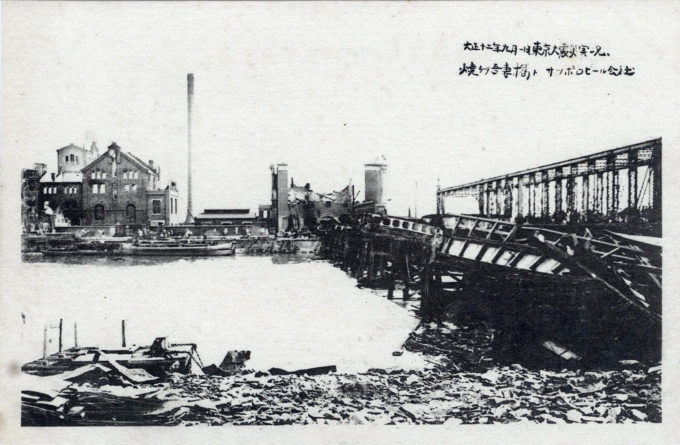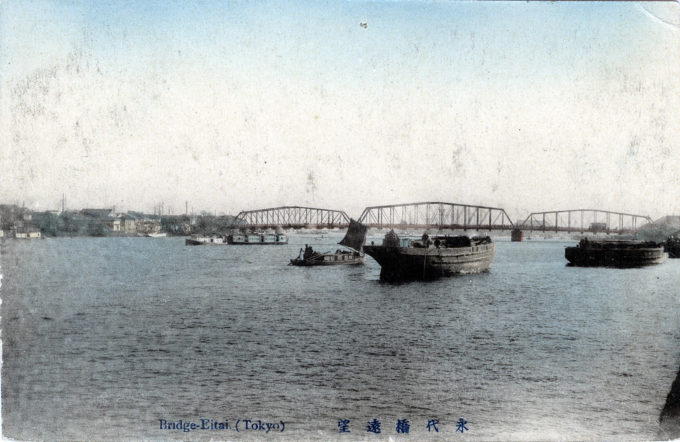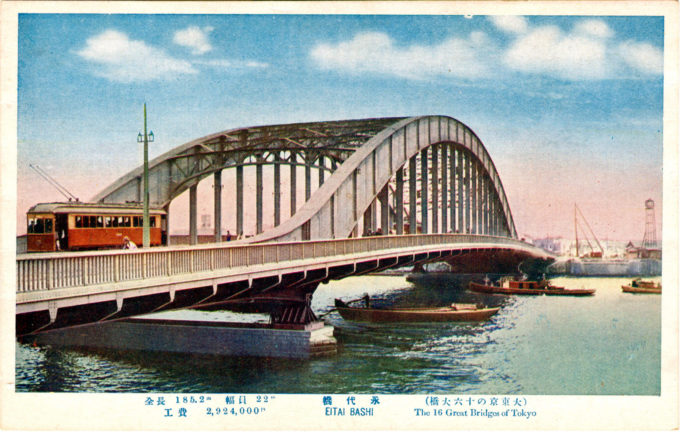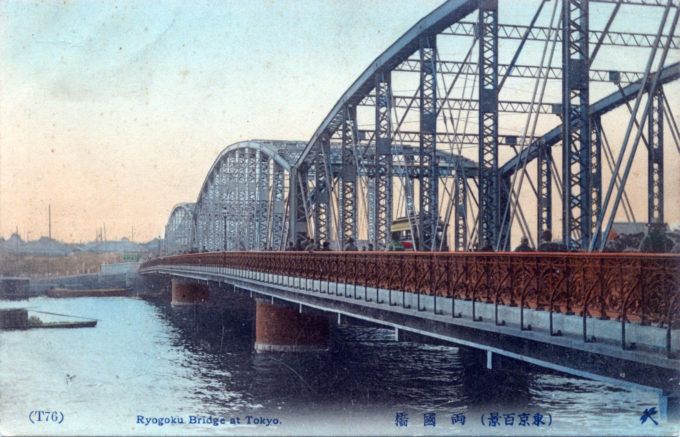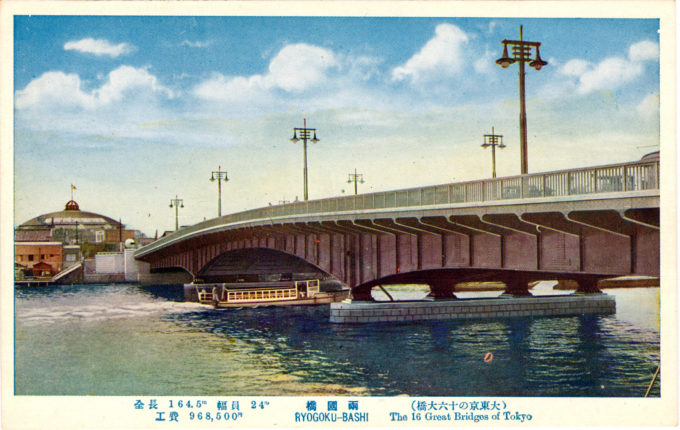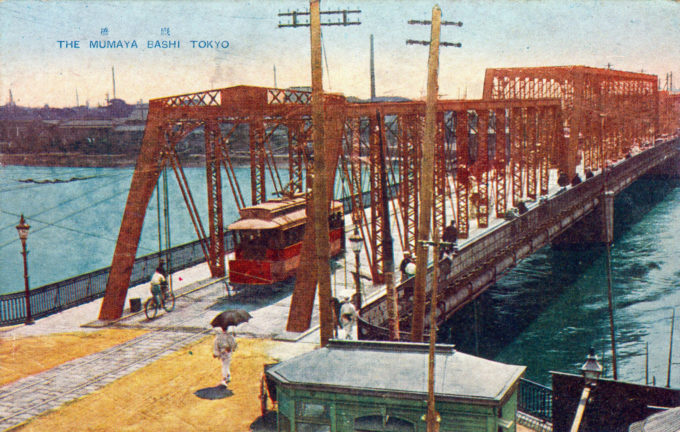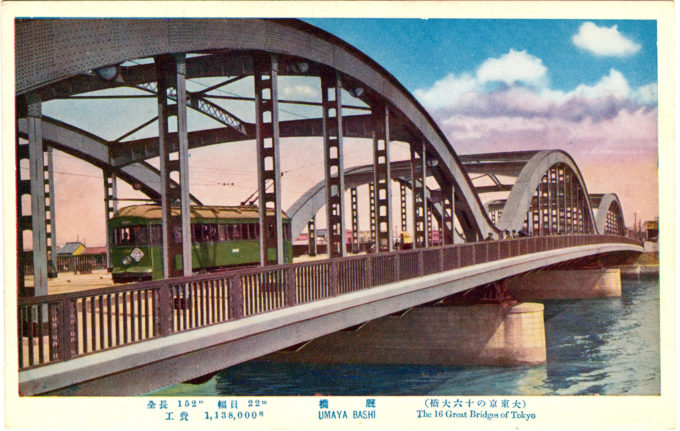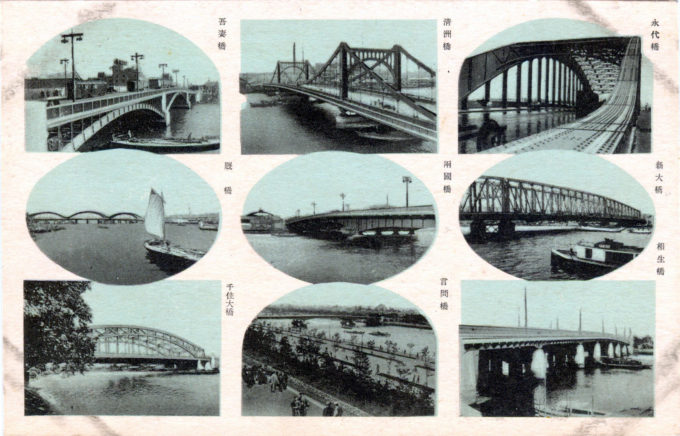
Post-earthquake Sumida River bridges, Tokyo, c. 1932.
Top row: Azuma-bashi (1931), Kiyosu-bashi (1928), Eitai-bashi (1924).
Middle row: Umaya-bashi (1929), Ryogoku-bashi (1932), Shino-hashi (1911).
Bottom row: Senjyu-bashi (1921), Kototoi-bashi (1928), Aioi-bashi (1926).
While already built prior to the earthquake and not part of any rebuilding plans, both the Shino-hashi, erected in 1911, and Senjyu-bashi, erected in 1921, were of such recent and durable construction that repairs could be made and neither needed replacement.
See also:
Azumabashi Bridge, Tokyo, c. 1910.
1923 Great Kanto Earthquake
Ryogoku Bridge, Sumida River, c. 1910
Kiyosu Bridge, c. 1930
“The earthquake did much damage to the bridges of Tokyo and Yokohama. In 1922 there were 583 bridges in the city of Tokyo … [Of these] 69 were shaken down by the earthquake shocks and 289 were destroyed by the ensuing fire. The destruction of these bridges seriously hindered communication and transportation at a most critical time and seriously impeded the rescue of those trapped by the flames. Many of the steel bridges had wooden floors; this proved to be a fatal defect, causing the destruction of bridges which would otherwise have remained undamaged.
“As a result of the lessons learned through the calamity the bridge-building program was realized to be a vital part of reconstruction work and an essential to any system providing for safety during similar emergencies in the future. The first consideration in bridge design was obviously that of safety against fire and earthquake damage; the second was that of esthetic appearance, in view of the efforts being made to create in Tokyo a model imperial capital.
“The new program being carried out by the Reconstruction Bureau includes 97 main bridges, in addition to 21 bridges over canals and 1 bridge in connection with land-adjustment work. Besides these, 308 bridges are to be constructed by the city of Tokyo … Of the new Tokyo bridges six of major importance will span the Sumida River, which runs through the heart of the city of Tokyo: Aioi-bashi, Eitai-bashi, Kiyosu-bashi, Kuramae-bashi, Komagata-bashi, and Kototoi-bashi.
– Reconstruction and Development of the Tokyo-Yokohama District, by J.H. Ehlers, United States Government Printing Office, 1928
Gallery: Examples of pre- vs.
post-earthquake Sumida River bridges
- Eitai-bashi, Tokyo, c. 1910. Erected of iron in 1897.
- Eitai-bashi Bridge, c. 1935. Erected in 1924.
- Ryogoku Bridge, c. 1910, looking east.
- Ryogoku-bashi Bridge, c. 1935. Completed in 1932.
- Mumaya (Umaya) Bridge, c. 1910.
- Umaya Bridge, c. 1935.
“Pre-earthquake [pre-1923] Tokyo held the world’s record for the number of bridges within municipal limits, mostly flimsy wooden structures designed for light foot passenger and cart traffic.
“… When Tokyo was organized as a Municipality in 1869 almost all the bridges, numbering 298, with the exception of the iron bridges over the Sumida River, were constructed of wood … In 1922, there 583 bridge structures, classified into 47 iron, 189 stone, and 347 wooden bridges covering an area of 24,183 tsubo [~ 260k sq. meters].
“… The development of surface car and motor truck transportation, coupled with the abnormal extension of the tramway lines, compelled the adoption of a bridge building program that would meet the new traffic requirements, and in 1921 the Municipal Assembly approved a project for the construction of the Eitaiashi and 16 other large bridges extending over a period of four years. Work on this program was well under way when the earthquake and fire presented the opportunity to the Government to lay out [a] new street system with an entirely new bridge-building program.
“… When the Reconstruction Bureau and the municipal and prefectural governments complete their new program there will be a total of 867 new bridges in the city of Tokyo.”
– “The Bridges of Tokyo”, The Far Eastern Review, June-July 1925


